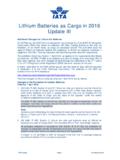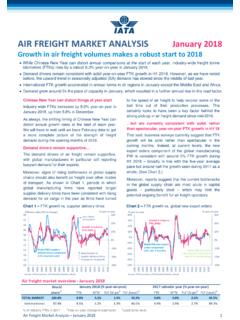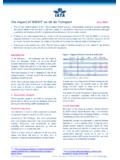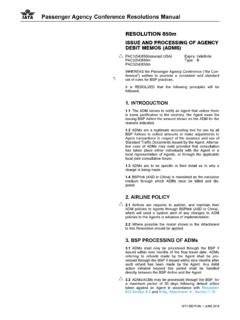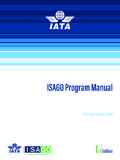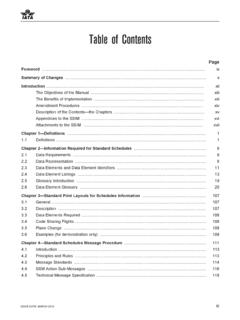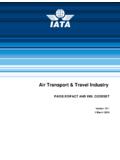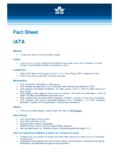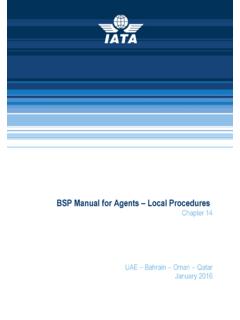Transcription of DGR EN 60th FrontMatter p-i-xxxii
1 Introduction SIGNIFICANT CHANGES AND AMENDMENTS TO THE 60TH EDITION (2019). The 60th edition of the IATA Dangerous Goods Regulations incorporates all amendments made by the ICAO. Dangerous Goods Panel in developing the content of the 2019 2020 edition of the ICAO Technical Instructions as well as changes adopted by the IATA Dangerous Goods Board. The following list is intended to assist the user to identify the main changes introduced in this edition and must not be considered an exhaustive listing. The changes have been prefaced by the section or subsection in which the change occurs. General Throughout the 60th edition there are many instances where the word risk has been changed to hazard , subsidiary risk is now subsidiary hazard.
2 This change has been made to reflect the correct usage of the term risk to align to the meaning of risk in accordance with safety management systems (SMS) where safety risk is defined as: the predicted probability and severity of the consequences or outcomes of a hazard . 1 Limitations Training Requirements Examples have been added to provide an explanation of the 3-month window for recurrent training and the application of the original training expiry. 2 Limitations Dangerous Goods Carried by Passengers or Crew New text has been introduced to clarify that the most appropriate entry in that describes the item must be used and where an article contains more than one item of dangerous goods, all applicable provisions must be met.
3 In addition, requires that where a passenger's carry-on baggage cannot be accommodated in the cabin, the operator must verify with the passenger that the carry-on baggage item does not contain dangerous goods forbidden in checked baggage. Identifies that radiopharmaceuticals contained in a person following medical treatment and energy efficient lamps in retail packagings are not subject to these Regulations, consequently the provisions applicable have been deleted from and Table , and The provisions applicable to battery-powered mobility aids have been revised to simplify and standardise the requirements for loading in an aircraft where the operator is responsible for ensuring that the mobility aid is properly restrained and protected against damage from baggage or other cargo.
4 The term collapsible that was applied to lithium ion battery powered mobility aids has been deleted. State and Operator Variations There are a number of additions, deletions and amendments to variations submitted by States and operators. 3 Classification Clarification on the classification of ammonium nitrate fertilizers. Classification of infected animal material has been deleted. Significant changes to the provisions for the classification of corrosive substances and in particular the methods to assign packing groups to mixtures. These changes reflect the work of the UN Subcommittee with the GHS Subcommittee to better align the classification provisions for transport for Class 8 substances with those for supply and use.
5 (f) new classification criteria have been added to address hybrid lithium batteries that are comprised of lithium metal and lithium ion cells. (g) identifies that manufacturers and subsequent distributors of lithium cells or batteries must make available a summary of the UN tests with effect from 1 January 2020. New classification criteria have been added for energetic samples. New provisions for the classification of articles containing dangerous goods, This addresses the classification of articles where the type or quantity of dangerous goods that are an integral part of the article exceed that allowed as UN 3363. 60th EDITION, 1 JANUARY 2019. Dangerous Goods Regulations 4 Identification List of Dangerous Goods Amendments to the List of Dangerous Goods include: addition of twelve new UN numbers, UN 3537 to UN 3548, that have been assigned to articles containing dangerous goods in Classes 2, 3, 4, 5, 8 and 9 and Division.
6 Modification to the entries for UN 3316 Chemical kit and First aid kit to delete reference to packing groups II and III. The shipper must assign the appropriate packing group based on the most restrictive packing group in the kit as specified in special provision A44;. addition of stabilized to UN 3302, 2-Dimethylaminoethyl acrylate;. assignment of ID 8001 to Disilane. This has been done as a placeholder until the UN Subcommittee addresses a gap in the existing regulations for pyrophoric gases. The entry for disilane identifies that it is completely forbidden;. addition of a new entry, UN 3536, Lithium batteries installed in cargo transport unit. This entry is to address multi modal containers with installed lithium ion batteries, battery management systems and other electronics that function as a large fixed-base battery.
7 The emergency response drill code, ERG Code shown in column N, for all lithium battery entries has been changed from 9FZ to 12FZ . This reflects a change agreed by the ICAO DGP to identify that the inherent hazard for lithium batteries is not 9 No general inherent risk and a new drill number 12 Fire, heat, smoke, toxic and flammable vapour , was adopted. addition of a new entry, UN 3535, Toxic solid, flammable, inorganic, . Special Provisions Amendments to the special provisions include: replacement of A21, A134, A203 and A207, assigned to vehicles, which all become not used with a new special provision A214;. revision to A59 to include reference to a maximum gauge pressure under which the exception for unserviceable or damaged tyre assemblies applies.
8 Revision to A67 to include the test requirements for classification of non-spillable batteries from Packing Instruction 872;. revisions to A79 and A90 and change to A89 to become not used , to clarify the classification of ammonium nitrate fertilizers;. revision to A107 to address the transport of UN 3363, Dangerous goods in apparatus or Dangerous goods in machinery where the quantity of the dangerous goods exceeds the allowance in PI 962;. revision to A201 to include provisions permitting the transport of lithium metal or lithium ion batteries as cargo on passenger aircraft with the approval of the States of Origin, destination and operator. New special provisions have been added as follows: A213 Identifies that hybrid lithium batteries, which are comprised of lithium metal cells and lithium ion cells, must be assigned to UN 3090 or UN 3091 and the limits that apply when assigned to Section II.
9 A334 Identifies the conditions that apply to lithium batteries shipped under approval as provided by special provision A201;. A806 Provides information on how a shipper must determine the subsidiary hazard(s) for articles containing dangerous goods, and identifies that any subsidiary hazard must be shown on the Shipper's Declaration;. A807 Identifies that the assigned entry must not be used for disilane or other pyrophoric gases. 5 Packing Packing Instructions PI 200 and PI 218 Have been revised to clarify the terminology associated with the calculation of the pressure in the cylinder. PI 361 and PI 364 Has been revised to restrict UN 1308, Zirconium suspended in a flammable liquid in packing groups I and II to combination packagings with a maximum of 75 kg gross weight of the completed package.
10 60th EDITION, 1 JANUARY 2019. Introduction PI 459 Packing provisions for small quantities of energetic samples have been added. PI 620 and PI 650 The conditions for the pressure differential test and the temperature ranges have been separated to be stand-alone requirements. PI 958 Changes have been made to introduce the use of combination packagings, in addition to single packagings. PI 966 and PI 969 Clarification has been introduced into these packing instructions on the number of spare cells or batteries that may be in a package with equipment. 6 Packaging Specifications and Performance Tests This subsection has been revised to bring in reference to new ISO standards and also to identify the period during which the ISO standards may be applied for manufacture and also after which time the standards may no longer be used.
